Herbal medicine
| This article is part of a series on |
| Alternative medicine |
|---|
 |
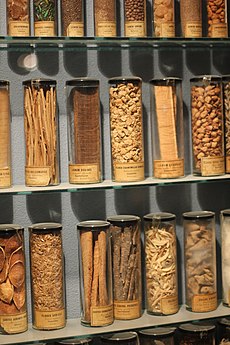
Herbal medicine (also called herbalism, phytomedicine or phytotherapy) is the study of
Paraherbalism describes alternative and pseudoscientific practices of using unrefined plant or animal extracts as unproven medicines or health-promoting agents.[1][4][6][7] Paraherbalism relies on the belief that preserving various substances from a given source with less processing is safer or more effective than manufactured products, a concept for which there is no evidence.[6]
History
Archaeological evidence indicates that the use of
Modern herbal medicine
The World Health Organization (WHO) estimates that 80 percent of the population of some Asian and African countries presently use herbal medicine for some aspect of primary health care.[15]
Some prescription drugs have a basis as herbal remedies, including artemisinin,[16] digitalis, quinine and taxanes.
Regulatory review
In 2015, the
According to Cancer Research UK as of 2015, "there is currently no strong evidence from studies in people that herbal remedies can treat, prevent or cure cancer".[5]
Prevalence of use
The use of herbal remedies is more prevalent in people with
Herbal preparations
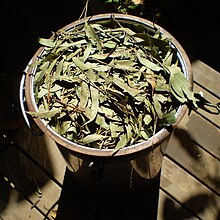
There are many forms in which herbs can be administered, the most common of which is a liquid consumed as a herbal tea or a (possibly diluted) plant extract.[25]
Tinctures are alcoholic extracts of herbs, which are generally stronger than herbal teas.[27] Tinctures are usually obtained by combining pure ethanol (or a mixture of pure ethanol with water) with the herb. A completed tincture has an ethanol percentage of at least 25% (sometimes up to 90%).[26] Non-alcoholic tinctures can be made with glycerin but it is believed to be less absorbed by the body than alcohol based tinctures and has a shorter shelf life.[28] Herbal wine and elixirs are alcoholic extract of herbs, usually with an ethanol percentage of 12–38%.[26] Extracts include liquid extracts, dry extracts, and nebulisates. Liquid extracts are liquids with a lower ethanol percentage than tinctures. They are usually made by vacuum distilling tinctures. Dry extracts are extracts of plant material that are evaporated into a dry mass. They can then be further refined to a capsule or tablet.[26]
The exact composition of a herbal product is influenced by the method of extraction. A tea will be rich in
Many herbs are applied topically to the skin in a variety of forms. Essential oil extracts can be applied to the skin, usually diluted in a carrier oil. Many essential oils can burn the skin or are simply too high dose used straight; diluting them in olive oil or another food grade oil such as almond oil can allow these to be used safely as a topical. Salves, oils, balms, creams, and lotions are other forms of topical delivery mechanisms. Most topical applications are oil extractions of herbs. Taking a food grade oil and soaking herbs in it for anywhere from weeks to months allows certain phytochemicals to be extracted into the oil. This oil can then be made into salves, creams, lotions, or simply used as an oil for topical application. Many massage oils, antibacterial salves, and wound healing compounds are made this way.[29]
Inhalation, as in aromatherapy, can be used as a treatment.[30][31][32]
Safety

Consumption of herbs may cause adverse effects.[34] Furthermore, "adulteration, inappropriate formulation, or lack of understanding of plant and drug interactions have led to adverse reactions that are sometimes life threatening or lethal."[35] Proper double-blind clinical trials are needed to determine the safety and efficacy of each plant before medical use.[36]
Although many consumers believe that herbal medicines are safe because they are natural, herbal medicines and synthetic drugs may interact, causing toxicity to the consumer. Herbal remedies can also be dangerously contaminated, and herbal medicines without established efficacy, may unknowingly be used to replace prescription medicines.[37]
Standardization of purity and dosage is not mandated in the United States, but even products made to the same specification may differ as a result of biochemical variations within a species of plant.[38] Plants have chemical defense mechanisms against predators that can have adverse or lethal effects on humans. Examples of highly toxic herbs include poison hemlock and nightshade.[39] They are not marketed to the public as herbs, because the risks are well known, partly due to a long and colorful history in Europe, associated with "sorcery", "magic" and intrigue.[40] Although not frequent, adverse reactions have been reported for herbs in widespread use.[41] On occasion serious untoward outcomes have been linked to herb consumption. A case of major potassium depletion has been attributed to chronic licorice ingestion,[42] and consequently professional herbalists avoid the use of licorice where they recognize that this may be a risk. Black cohosh has been implicated in a case of liver failure.[43] Few studies are available on the safety of herbs for pregnant women,[44] and one study found that use of complementary and alternative medicines are associated with a 30% lower ongoing pregnancy and live birth rate during fertility treatment.[45]
Examples of herbal treatments with likely cause-effect relationships with adverse events include
There is also concern with respect to the numerous well-established interactions of herbs and drugs.[35][47] In consultation with a physician, usage of herbal remedies should be clarified, as some herbal remedies have the potential to cause adverse drug interactions when used in combination with various prescription and over-the-counter pharmaceuticals, just as a customer should inform a herbalist of their consumption of actual prescription and other medication.[48][49]
For example, dangerously low blood pressure may result from the combination of a herbal remedy that lowers blood pressure together with prescription medicine that has the same effect. Some herbs may amplify the effects of anticoagulants.[50] Certain herbs as well as common fruit interfere with cytochrome P450, an enzyme critical to much drug metabolism.[51]
In a 2018 study, FDA identified active pharmaceutical additives in over 700 of analyzed dietary supplements sold as "herbal", "natural" or "traditional".[52] The undisclosed additives included "unapproved antidepressants and designer steroids", as well as prescription drugs, such as sildenafil or sibutramine.
Labeling accuracy
A 2013 study found that one-third of herbal supplements sampled contained no trace of the herb listed on the label.
Researchers at the University of Adelaide found in 2014 that almost 20 percent of herbal remedies surveyed were not registered with the Therapeutic Goods Administration, despite this being a condition for their sale.[54] They also found that nearly 60 percent of products surveyed had ingredients that did not match what was on the label. Out of 121 products, only 15 had ingredients that matched their TGA listing and packaging.[54]
In 2015, the
Practitioners of herbalism
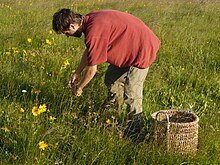
In some countries, formalized training and minimum education standards exist for herbalists, although these are not necessarily uniform within or between countries. In Australia, for example, the self-regulated status of the profession (as of 2009) resulted in variable standards of training, and numerous loosely formed associations setting different educational standards.[57] One 2009 review concluded that regulation of herbalists in Australia was needed to reduce the risk of interaction of herbal medicines with prescription drugs, to implement clinical guidelines and prescription of herbal products, and to assure self-regulation for protection of public health and safety.[57] In the United Kingdom, the training of herbalists is done by state-funded universities offering Bachelor of Science degrees in herbal medicine.[58] In the United States, according to the American Herbalist Guild, "there is currently no licensing or certification for herbalists in any state that precludes the rights of anyone to use, dispense, or recommend herbs."[59] However, there are U.S. federal restrictions for marketing herbs as cures for medical conditions, or essentially practicing as an unlicensed physician.
United States herbalism fraud
Over the years 2017–2021, the
Government regulations
The World Health Organization (WHO), the specialized agency of the United Nations (UN) that is concerned with international public health, published Quality control methods for medicinal plant materials in 1998 to support WHO Member States in establishing quality standards and specifications for herbal materials, within the overall context of quality assurance and control of herbal medicines.[64]
In the European Union (EU), herbal medicines are regulated under the Committee on Herbal Medicinal Products.[65]
In the United States, herbal remedies are regulated
Canadian regulations are described by the Natural and Non-prescription Health Products Directorate which requires an eight-digit Natural Product Number or Homeopathic Medicine Number on the label of licensed herbal medicines or dietary supplements.[69]
Some herbs, such as
Scientific criticism
Herbalism has been criticized as a potential "minefield" of unreliable product quality, safety hazards, and potential for misleading health advice.[1][7] Globally, there are no standards across various herbal products to authenticate their contents, safety or efficacy,[38] and there is generally an absence of high-quality scientific research on product composition or effectiveness for anti-disease activity.[7][71] Presumed claims of therapeutic benefit from herbal products, without rigorous evidence of efficacy and safety, receive skeptical views by scientists.[1]
Unethical practices by some herbalists and manufacturers, which may include false advertising about health benefits on product labels or literature,[7] and contamination or use of fillers during product preparation,[38][72] may erode consumer confidence about services and products.[73][74]
Paraherbalism
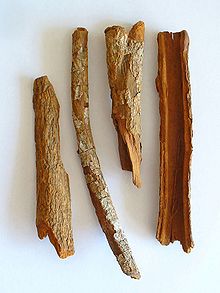
Paraherbalism is the pseudoscientific use of extracts of plant or animal origin as supposed medicines or health-promoting agents.[1][6][7] Phytotherapy differs from plant-derived medicines in standard pharmacology because it does not isolate and standardize the compounds from a given plant believed to be biologically active. It relies on the false belief that preserving the complexity of substances from a given plant with less processing is safer and potentially more effective, for which there is no evidence either condition applies.[6]
Phytochemical researcher Varro Eugene Tyler described paraherbalism as "faulty or inferior herbalism based on pseudoscience", using scientific terminology but lacking scientific evidence for safety and efficacy. Tyler listed ten fallacies that distinguished herbalism from paraherbalism, including claims that there is a conspiracy to suppress safe and effective herbs, herbs can not cause harm, that whole herbs are more effective than molecules isolated from the plants, herbs are superior to drugs, the doctrine of signatures (the belief that the shape of the plant indicates its function) is valid, dilution of substances increases their potency (a doctrine of the pseudoscience of homeopathy), astrological alignments are significant, animal testing is not appropriate to indicate human effects, anecdotal evidence is an effective means of proving a substance works and herbs were created by God to cure disease. Tyler suggests that none of these beliefs have any basis in fact.[6][75]
Traditional systems
Africa
Up to 80% of the population in Africa uses traditional medicine as primary health care.[76]
Americas
Native Americans used about 2,500 of the approximately 20,000 plant species that are native to North America.[77]
In
China
Some researchers trained in both Western and
India
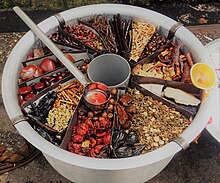
In India,
Indonesia

In
Though possibly influenced by Indian
Beliefs
Herbalists tend to use extracts from parts of plants, such as the roots or leaves,[88] believing that plants are subject to environmental pressures and therefore develop resistance to threats such as radiation, reactive oxygen species and microbial attack to survive, providing defensive phytochemicals of use in herbalism.[88][89]
Use of plants by animals
Indigenous healers often claim to have learned by observing that sick animals change their food preferences to nibble at bitter herbs they would normally reject.
See also
- Chinese herbology
- Ethnobotany
- Ethnomedicine
- Herbal
- Medicinal fungi
- List of plants used in herbalism
- Traditional medicine
- Traditional Knowledge Digital Library
References
- ^ PMID 17625521.
- ^ "This Ancient Chinese Remedy Helped Win the Nobel Prize". Time. Archived from the original on 3 November 2022. Retrieved 11 October 2021.
- PMID 26481135.
- ^ ISBN 9780826194268.
- ^ a b "Herbal medicine". Cancer Research UK. 2 February 2015. Archived from the original on 29 May 2019. Retrieved 12 November 2018.
- ^ a b c d e Tyler VE (31 August 1999). "False Tenets of Paraherbalism". Quackwatch. Archived from the original on 11 November 2009. Retrieved 29 October 2016.
- ^ a b c d e Barrett S (23 November 2013). "The Herbal Minefield". Quackwatch. Archived from the original on 5 August 2020. Retrieved 25 February 2017.
- )
- PMID 26281720.
- ISBN 9780470289532.
- ^ Hong F (2004). "History of Medicine in China" (PDF). McGill Journal of Medicine. 8 (1): 7984. Archived from the original (PDF) on 1 December 2013.
- ISBN 978-0-520-92849-7.
- ISBN 978-0-8018-2726-6.
- ISBN 978-0-674-03572-0.
- ^ "Traditional medicine". Archived from the original on 27 July 2008.
- PMID 26481135.
- ^ Baggoley C (2015). "Review of the Australian Government Rebate on Natural Therapies for Private Health Insurance" (PDF). Australian Government – Department of Health. Archived from the original (PDF) on 26 June 2016. Retrieved 12 December 2015.
- ^ "Assessment of clinical safety and efficacy in the preparation of Community herbal monographs for well-established and of Community herbal monographs/entries to the Community list for traditional herbal medicinal products/substances/preparations". European Medicines Agency. 2017. Archived from the original on 26 February 2017. Retrieved 25 February 2017.
- ^ "Herbs at a Glance". National Center for Complementary and Integrative Health, US National Institutes of Health. 21 November 2016. Archived from the original on 30 March 2019. Retrieved 24 February 2017.
- ^ "Clinicaltrials.gov, a registry of studies on herbal medicine". Clinicaltrials.gov, US National Institutes of Health. 2017. Archived from the original on 1 April 2019. Retrieved 25 February 2017.
- PMID 10352166.
- PMID 11815504.
- PMID 24241097.
- PMID 18955327.
- ^ ISBN 9780470474211.
- ^ a b c d Groot Handboek Geneeskrachtige Planten by Geert Verhelst
- ISBN 9780895949905.
- ISBN 978-0-443-07277-2.
- ISBN 978-1452851433.
- ^ "Aromatherapy". University of Maryland Medical Center. 2017. Archived from the original on 25 October 2017.
- S2CID 205422999.
- PMID 19041706.
- PMID 23506688.
- PMID 11242573.
- ^ PMID 11297844.
- PMID 17761132.
- PMID 17913230.
- ^ PMID 24120035.
- PMID 9776969.
- PMID 17526134.
- PMID 11759460.
- S2CID 35033559.
- S2CID 28255622.
- S2CID 35882289.
- PMID 19359338.
- PMID 9528737.
- PMID 22236736.
- ^ "Herb-Drug Interactions". NCCIH. 10 September 2015. Archived from the original on 26 June 2019. Retrieved 26 June 2019.
- PMID 11961942.
- from the original on 12 October 2011. Retrieved 28 December 2010.
- PMID 17969314.
- ^ Cohen R (12 October 2018). "No Wonder It Works So Well: There May Be Viagra In That Herbal Supplement". NPR.org. Archived from the original on 13 October 2018. Retrieved 13 October 2018.
- ^ O'Connor A (3 November 2012). "Herbal Supplements Are Often Not What They Seem". New York Times. Archived from the original on 18 October 2017. Retrieved 12 November 2013.
- ^ a b Carroll L (24 February 2014). "Herbal medicines: Study raises alarm over labelling". The Sydney Morning Herald, Australia. Archived from the original on 26 February 2017. Retrieved 25 February 2017.
- ^ O'Connor A (3 February 2015). "New York Attorney General Targets Supplements at Major Retailers". The New York Times. Archived from the original on 28 April 2019. Retrieved 3 February 2015.
- ^ Kaplan S (3 February 2015). "GNC, Target, Wal-Mart, Walgreens accused of selling adulterated 'herbals'". The Washington Post. Archived from the original on 24 May 2019. Retrieved 3 February 2015.
- ^ PMID 22312205.
- ^ "Becoming a Herbalist". The National Institute of Medical Herbalists. Archived from the original on 26 June 2019. Retrieved 26 June 2019.
- ^ "Legal and Regulatory FAQs". American Herbalist Guild. 24 January 2014. Archived from the original on 24 November 2020. Retrieved 25 November 2020.
- ^ "2017 Warning Letters – Health Fraud". US Food and Drug Administration. 27 February 2017. Archived from the original on 9 May 2021. Retrieved 2 April 2021.
- ^ Porter Jr SE (25 May 2017). "Warning Letter – Herbal Doctor Remedies". U.S. Food and Drug Administration. Archived from the original on 2 December 2020. Retrieved 25 November 2020.
- ^ a b "Fraudulent Coronavirus Disease 2019 (COVID-19) Products". US Food and Drug Administration. 2 April 2021. Archived from the original on 5 March 2021. Retrieved 2 April 2021.
- ^ Bellamy J (19 November 2020). "FDA and FTC issue more warning letters citing products and services making illegal COVID claims". Science-Based Medicine. Archived from the original on 14 January 2021. Retrieved 2 April 2021.
- ^ "WHO Quality Control Methods for Herbal Materials" (PDF). World Health Organization, Geneva, Switzerland. 2011. Archived from the original (PDF) on 1 August 2014.
- ^ "Herbal medicinal products". European Medicines Agency. 2017. Archived from the original on 15 March 2017. Retrieved 25 February 2017.
- ^ "Botanical Dietary Supplements". Office of Dietary Supplements, US National Institutes of Health. June 2011. Archived from the original on 20 October 2018. Retrieved 25 February 2017.
- ^ "US Dietary Supplement Health and Education Act of 1994". Food and Drug Administration. Archived from the original on 31 May 2009. Retrieved 16 December 2019.
- S2CID 35766876.
- ^ "Licensed Natural Health Products Database: What is it?". Health Canada. 8 December 2016. Archived from the original on 4 June 2017. Retrieved 25 February 2017.
- ^ FDA Issues Regulation Prohibiting Sale of Dietary Supplements Containing Ephedrine Alkaloids and Reiterates Its Advice That Consumers Stop Using These Products Archived 15 September 2007 at the Wayback Machine
- ^ "WHO Traditional Medicine Strategy, 2014–2023" (PDF). World Health Organization. 2013. p. 41. Archived (PDF) from the original on 18 November 2017. Retrieved 25 February 2017.
- PMID 22305255.
- PMID 13129992.
- PMID 22511890.
- ISBN 978-0789001597.
- ^ "Traditional medicine, Factsheet No. 134". World Health Organization. May 2003. Archived from the original on 8 June 2003.
- ISBN 9780792340669.
- PMID 17090303.
- PMID 27143269.
- ^ Kala CP (2006). "Preserving Ayurvedic herbal formulations by Vaidyas: The traditional healers of the Uttaranchal Himalaya region in India". HerbalGram. 70: 42–50. Archived from the original on 18 February 2020. Retrieved 9 June 2020.
- ^ Kala CP (2005). "Health traditions of Buddhist community and role of amchis in trans-Himalayan region of India". Current Science. 89 (8): 1331–38.
- ^ Kala CP (2003). Medicinal plants of Indian trans-Himalaya. Dehradun: Bishen Singh Mahendra Pal Singh. p. 200.
- PMID 22654398.
- ^ Wahono T (21 February 2012). "Jejak Mataram Kuno di Sindoro" [Traces of Ancient Mataram in Sindoro]. KOMPAS (in Indonesian). Archived from the original on 9 June 2020. Retrieved 9 June 2020.
- ^ a b c "Jamu dan Lulur, Rahasia Cantik Para Putri Keraton". Tribun Jogja (in Indonesian). 21 May 2013. Archived from the original on 3 April 2019. Retrieved 4 November 2015.
- ^ Society, National Geographic (20 August 2020). "Dividing Species: Wallace Line Map". National Geographic Society. Archived from the original on 7 May 2022. Retrieved 4 May 2022.
- ISBN 978-962-593-503-4.[page needed]
- ^ PMID 10521203.
- .
- PMID 14506884.
- PMID 14506883.
Further reading
- Aronson JK (2008). Meyler's Side Effects of Herbal Medicines. Elsevier. ISBN 9780080932903.
- Braun L, Cohen M (2007). Herbs and Natural Supplements: An Evidence-Based Guide. Elsevier. ISBN 9780729537964.


